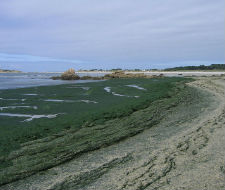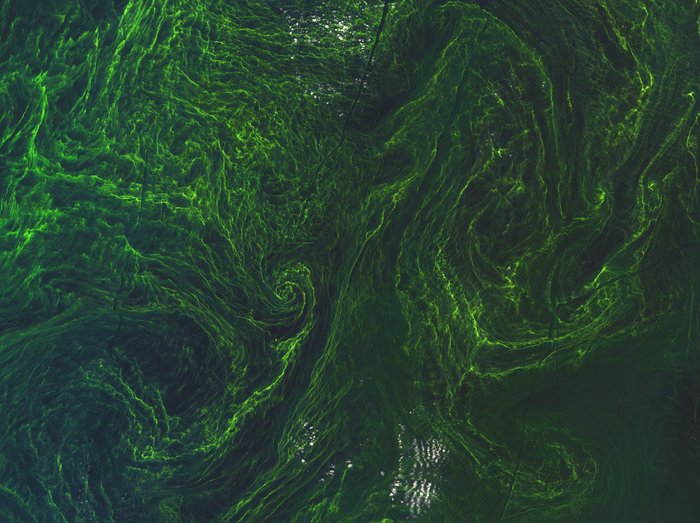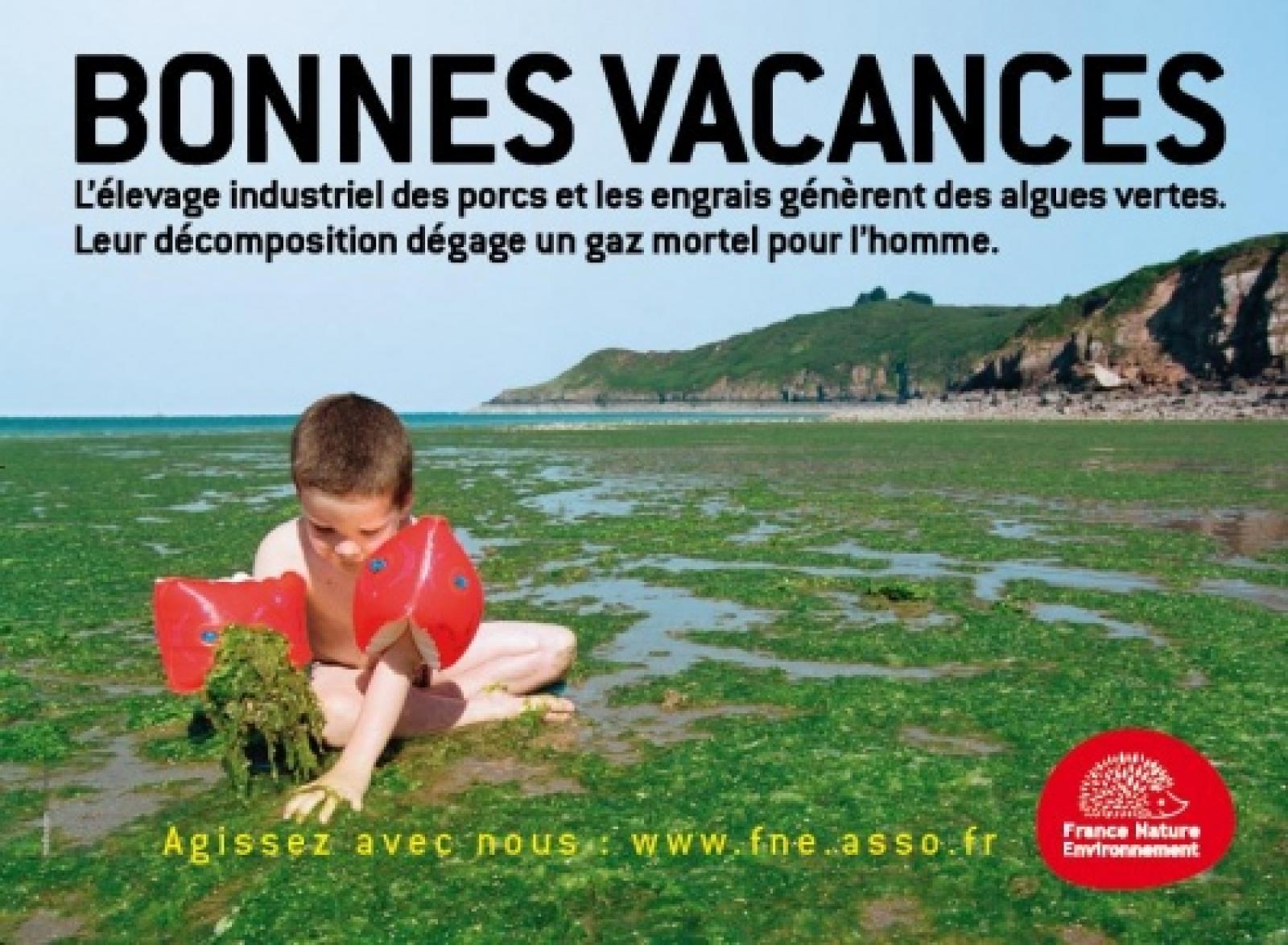Login Form
Newsletter
Support YEE
Deprecated: Methods with the same name as their class will not be constructors in a future version of PHP; plgContentJw_allvideos has a deprecated constructor in /home/html/yeenet.eu/public_html/www/archives/plugins/content/jw_allvideos/jw_allvideos.php on line 18
Deprecated: implode(): Passing glue string after array is deprecated. Swap the parameters in /home/html/yeenet.eu/public_html/www/archives/plugins/content/jw_allvideos/jw_allvideos.php on line 72
Green algae invasion on the French coasts |
|
(Thesupermat (Own work) [GFDL], What are these green algae (Ulva), and what is the problem? Ulva on its own is pretty inoffensive. It can even be edible! The problem is that on the French beaches (but also all around the world), their proliferation has become more than worrying. First, there is a health concern: after spending more than 24 hours on the shore, the algae start to putrefy and produce gas (hydrogen cyanide) which is toxic for human beings and other animals. Another consequence of the propagation of green algae is the rarefaction of oxygen in shallow waters, which could lead to the creation of "dead zones".
(In Brittany, eutrophication is mainly a consequence of industrial breeding - essentially pork, in this area - and the use of manure-based fertilizers for cultivations. A major factor of the proliferation of green algae comes from the intensive agriculture operating in the area. For their cultures, farmers use nitrogen-based fertilizers (for example liquid manure, which is made from animal excrement). These practices lead to the increasing presence of nitrates (oxygenated nitrogen) in water. When it rains over the farms, nitrates are brought to the rivers, and finally to the sea. Here is our problem: green algae are fond of these nutrients. That is why each spring, little Ulva decides to settle on French beaches and to start a very, very big family. This accelerated growth of green algae due to the abnormal presence of nutrients in water is called "eutrophication". In 2010, Brittany launched a green algae fighting plan (PLAV) that has produced some positive outcomes. But last summer, due to exceptional weather conditions (an important sunshine intensity and a particularly warm winter), it was party-time for green algae! In April, the amount of Ulva was three times and a half superior to the average proportion observed since 2002. And in July, the measurements showed that the rate of hydrogen cyanide produced by green algae reached twice the death level for a human being, so much that local authorities in Brittany started to consider beaches as "real minefields". The city councils usually try to pick up the algae whilst they are still fresh in order to avoid this toxic hazard. However, this is not a structural solution: this good old Ulva will always come back on the following year for more fun. "Dead zones": a bigger environmental concern
Tensions between farmers and ecologists France Nature Environnement's campaign
(“Have a good holiday!
In February 2011, the French association France Nature Environnement (FNE) started a poster campaign in order to raise awareness about human action on the environment. One poster showed a child playing on a beach covered by green algae. This provoked strong reaction from the agricultural world, but also from the region of Brittany who invoked that this kind of campaign was tarnishing its image. FNE explained that this poster was not targeting directly neither the farmers nor Brittany, and had to be understood as a call for mobilization against the intensive agricultural model, which is disastrous for the environment, as well as a way to denounce the governmental inaction towards this situation. However, some actors like the "Responsible and environmentally-respectful farmers' forum" (FARRE) argued that this kind of provocative campaign could actually erode the very important cooperation between farmers and local authorities regarding the green algae matter. Farmers and local administrations have indeed been working together since 2010 in order to reduce the production of nitrates. Due to this collective work, there has been a significant diminution of nitrates in water since the beginning of the green algae plan. However this was not enough to stop the exceptional propagation of green algae we have seen this summer. The return of the "green tide" has been frustrating for farmers, who feel like scapegoats: they are asked to reduce their nitrates emissions but they lack some support from the State, especially when it comes to funding. The transition to a more environmentally-respectful agriculture takes time and money, and the risk for farmers is to get a bad harvest for several years. Is the French government to blame? The green algae problem is not new. It has been discovered in the 70s, and researchers started to work on it since the 80s by monitoring the quality of water and trying to look for solutions. In 1991, the European Commission wrote the "nitrate directive" that asks the Member States to act in order to reduce the proportion of nutrients in water. However, the French State has not observed this directive and has been too slow to take actions. As a result, in 2002 and 2008 France was condemned two times by the European court for "failure to fulfill its obligations". The main accusation was that the funds promised by the government to help farmers and local authorities to deal with the problem never arrived on time. Moreover, the government has taken many times an ambiguous stand concerning agricultural environmental regulations, opting too often for inaction in order to "lighten" the farmers, instead of giving them a strong support for their transition.
Which solutions? New plan, efficient alternatives This summer, Brittany launched a second green algae fighting plan (PLAV 2) that should gather 55.5 million euros from the State, Brittany, and the national water agency. The new objective, more ambitious, is to lower the nitrate content in water under 10 mg/l. It also plans to support the region for algae collection, and to bring help to farmers so they can improve their practices. In order to contain the phenomenon, another solution is to cover the ground with grazing and/or organic cultivations. This method has been used successfully during the first green algae plan. The aim is to avoid bare soil by covering it with plants, in order to hold back the proliferation of green algae in the area. Changing the system? The only efficient solution in order to face this crisis is to change structurally the way that our agriculture works. And in this way, the government has an important part to play. Instead of being indulgent towards farmers regarding environmental norms, it would be way more appropriate to make sure that these norms are respected, and on the other side to support actively new agricultural practices that are better for the environment. This means of course financial support, but also ensuring new prospects for the farmers who are asked to change their methods. Local authorities in Brittany have already started to support smaller and innovative cultivations by choosing to serve local and organic food in school canteens. Therefore, the most important question is not "Who is to blame?", but "What can we do about it, collectively?". This change has indeed to be collective. The whole agri-food industry has to take part in this transition, for farmers cannot take all the risks on their own. At the end of the chain, the consumer him/herself has to take a step for change. This is not easy to ask people to commit to something for which they may not see results in a lifetime. But it is worth a try, should it be for our own quality of life, for the lives of our children and grand-children, or simply for sparing our planet from another natural disaster. (Thesupermat (Own work) [GFDL],
Coline Malot |












